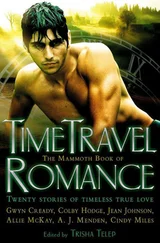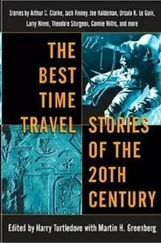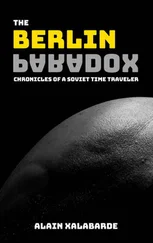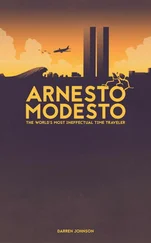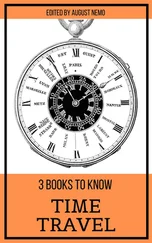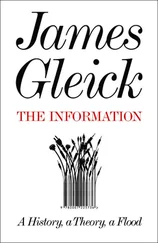James Gleick - Time Travel
Здесь есть возможность читать онлайн «James Gleick - Time Travel» — ознакомительный отрывок электронной книги совершенно бесплатно, а после прочтения отрывка купить полную версию. В некоторых случаях можно слушать аудио, скачать через торрент в формате fb2 и присутствует краткое содержание. Год выпуска: 2016, Издательство: Knopf Doubleday Publishing Group, Жанр: Старинная литература, на английском языке. Описание произведения, (предисловие) а так же отзывы посетителей доступны на портале библиотеки ЛибКат.
- Название:Time Travel
- Автор:
- Издательство:Knopf Doubleday Publishing Group
- Жанр:
- Год:2016
- ISBN:нет данных
- Рейтинг книги:5 / 5. Голосов: 1
-
Избранное:Добавить в избранное
- Отзывы:
-
Ваша оценка:
- 100
- 1
- 2
- 3
- 4
- 5
Time Travel: краткое содержание, описание и аннотация
Предлагаем к чтению аннотацию, описание, краткое содержание или предисловие (зависит от того, что написал сам автор книги «Time Travel»). Если вы не нашли необходимую информацию о книге — напишите в комментариях, мы постараемся отыскать её.
Time Travel — читать онлайн ознакомительный отрывок
Ниже представлен текст книги, разбитый по страницам. Система сохранения места последней прочитанной страницы, позволяет с удобством читать онлайн бесплатно книгу «Time Travel», без необходимости каждый раз заново искать на чём Вы остановились. Поставьте закладку, и сможете в любой момент перейти на страницу, на которой закончили чтение.
Интервал:
Закладка:
We know that the light of the stars is ancient light, that distant galaxies reveal themselves to us only as they once were, not as they now are. As John Banville reminds us in his novel of that name, ancient light is all we have: “Even here, at this table, the light that is the image of my eyes takes time, a tiny time, infinitesimal, yet time, to reach your eyes, and so it is that everywhere we look, everywhere, we are looking into the past.” *4(Can we peer into the future as well? That clever time traveler Joyce Carol Oates says via Twitter, “As minutes are required for the sun’s light to reach us, we are living always in a sunlit past. Just the reverse, reading bound galleys.”)
When everything reaching our senses comes from the past, when no observer lives in the now of any other observer, the distinction between past and future begins to decay. Events in our universe can be connected, such that one is the cause of the other, but, alternatively, they can be close enough in time and far enough apart that they cannot be connected and no one can even say which came first. (Outside the light cone, says the physicist.) We are more isolated, then, than we may have imagined, alone in our corners of spacetime. You know how fortune-tellers pretend to know the future? It turns out, said Richard Feynman, that no fortune-teller can even know the present.
Einstein’s powerful ideas spread in the public press as rapidly as in the physics journals and disrupted the placid course of philosophy. The philosophers were surprised and outgunned. Bergson and Einstein clashed publicly in Paris and privately by post and seemed to be speaking different languages: one scientific, measured, practical; the other psychological, flowing, untrustworthy. “ ‘The time of the universe’ discovered by Einstein and ‘the time of our lives’ associated with Bergson spiraled down dangerously conflicting paths, splitting the century into two cultures,” notes the science historian Jimena Canales. We are Einsteinian when we search for simplicity and truth, Bergsonian when we embrace uncertainty and flux. Bergson continued to place human consciousness at the center of time, while Einstein saw no place for spirit in a science that relied on clocks and light. “Time is for me that which is most real and necessary,” wrote Bergson; “it is the necessary condition of action. What am I saying? It is action itself.” Before an audience of intellectuals at the Société Française de Philosophie in April 1922, Einstein was adamant: “The time of the philosophers does not exist.” Einstein, it seems, prevailed.
What does his framework mean for our understanding of the true nature of things? His biographer Jürgen Neffe sums up the situation judiciously. “Einstein provided no explanations for these phenomena,” he says. “No one knows what light and time really are. We are not told what something is. The special theory of relativity merely provides a new rule for measuring the world—a perfectly logical construct that surmounts earlier contradictions.”
—
HERMANN MINKOWSKI READ Einstein’s 1905 paper on special relativity with special interest. He had been Einstein’s mathematics teacher in Zurich. He was forty-four years old and Einstein was twenty-nine. Minkowski saw that Einstein had knocked the concept of time “from its high seat,” had shown, indeed, that there is no time, but only times. But he thought that his former student had left the big job unfinished—had stopped short of stating the new truth about the nature of all reality. So Minkowski prepared a lecture. He delivered it at a scientific meeting in Cologne on September 21, 1908, and it is famous.
“Raum und Zeit” was his title, “Space and Time,” and his mission was to declare both concepts null and void. “The views of space and time which I wish to lay before you have sprung from the soil of experimental physics, and therein lies their strength,” he began grandly. “They are radical. Henceforth space by itself, and time by itself, are doomed to fade away into mere shadows, and only a kind of union of the two will preserve an independent reality. ”
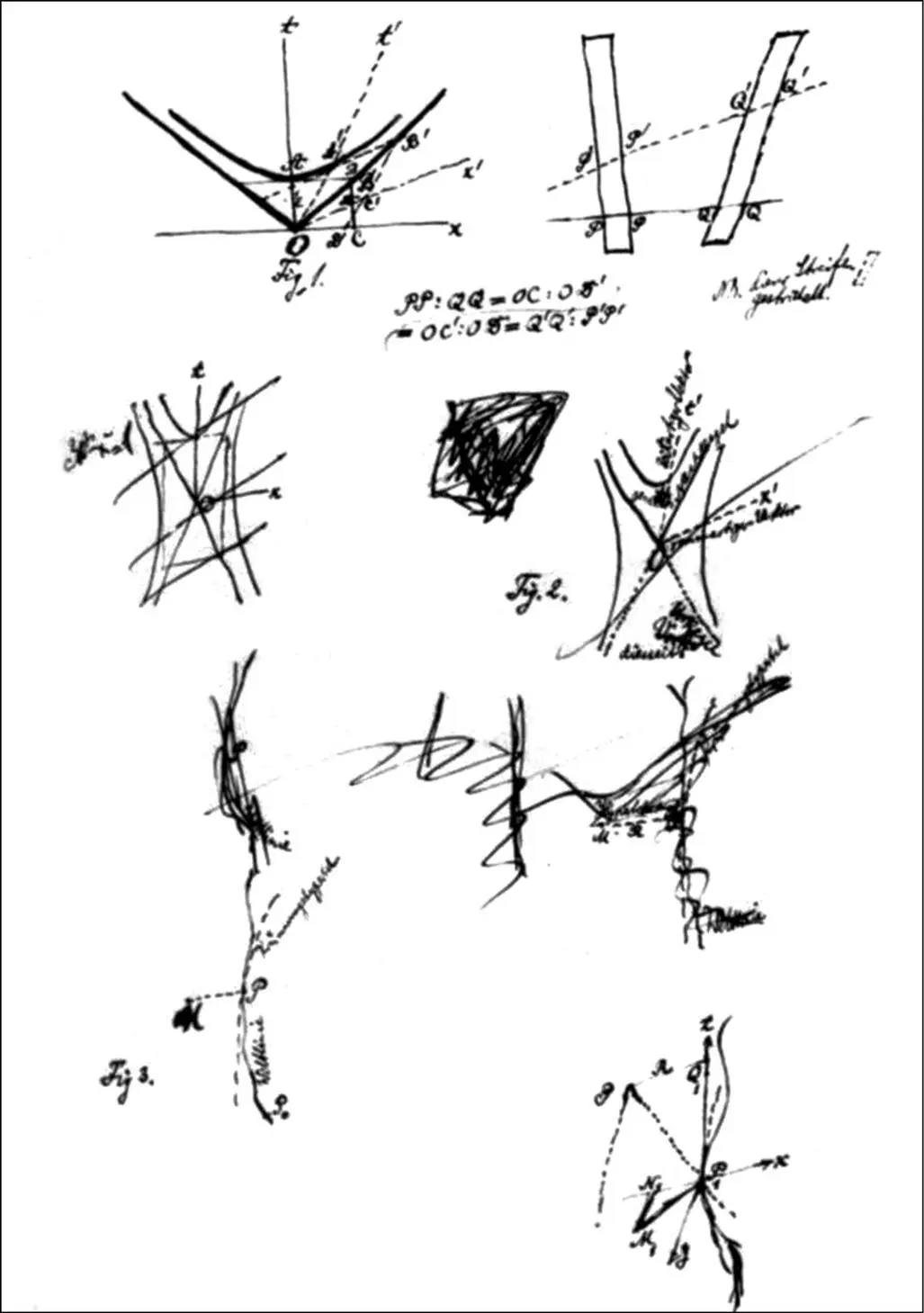
Credit 4.1
He reminded his listeners that space is denoted by three orthogonal coordinates, x, y, z, for length, breadth, and thickness. Let t denote time. With a piece of chalk, he said, he could draw four axes on the blackboard: “the somewhat greater abstraction associated with the number 4 does not hurt the mathematician.” And so on. He was excited. This was “a new conception of space and time,” he declared; “the first of all laws of nature.” He called this conception the “principle of the absolute world.”
Four numbers, x, y, z, t, define a “world point.” Together, all the world points that trace an object’s existence from birth to death form a “world line.” And what shall we call the whole shebang?
The multiplicity of all thinkable x, y, z, t systems of values we will christen the world.
Die Welt! Good name. But we just call it spacetime now. (The continuum.) If we resist (“Because I know that time is always time / And place is always and only place,” said T. S. Eliot), we do so in vain.
It was a bit of misdirection for Minkowski to begin by saying his lecture was grounded in experimental physics. His true subject was the power of abstract mathematics to reshape our understanding of the universe. He was a geometer above all. The physicist and historian Peter Galison puts it this way: “Where Einstein manipulated clocks, rods, light beams, and trains, Minkowski played with grids, surfaces, curves, and projections.” He thought in terms of the most profound visual abstraction.
“Mere shadows,” Minkowski said. That was not mere poetry. He meant it almost literally. Our perceived reality is a projection, like the shadows projected by the fire in Plato’s cave. If the world—the absolute world—is a four-dimensional continuum, then all that we perceive at any instant is a slice of the whole. Our sense of time: an illusion. Nothing passes; nothing changes. The universe—the real universe, hidden from our blinkered sight—comprises the totality of these timeless, eternal world lines. “I would fain anticipate myself,” said Minkowski in Cologne, “by saying that in my opinion physical laws might find their most perfect expression as reciprocal relations between these world lines.” Three months later he was dead of a ruptured appendix.
Thus the idea of time as a fourth dimension crept forward. It did not happen all at once. In 1908 Scientific American “simply explained” the fourth dimension as a hypothetical space analogous to the first three: “For passing into the fourth dimension, we should pass out of our present world.” The next year the magazine sponsored an essay contest on the topic “The Fourth Dimension,” and not one of the winners or runners-up considered it to be time—notwithstanding the German physicists and the English writer of fantastic fiction. The space-time continuum was radical indeed. Max Wien, an experimental physicist, described his initial reaction as “a slight brain-shiver—now space and time appear conglomerated together in a gray, miserable chaos.” *5It offends common sense. “The texture of Space is not that of Time,” cries Vladimir Nabokov, “and the piebald four-dimensional sport bred by relativists is a quadruped with one leg replaced by the ghost of a leg.” If these critics sound Filbyish, even Einstein did not immediately embrace Minkowski’s vision: “überflüssige Gelehrsamkeit,” he called it—superfluous learnedness. But Einstein came around. When his friend Besso died in 1955, Einstein consoled his family with words that have been quoted many times:
Читать дальшеИнтервал:
Закладка:
Похожие книги на «Time Travel»
Представляем Вашему вниманию похожие книги на «Time Travel» списком для выбора. Мы отобрали схожую по названию и смыслу литературу в надежде предоставить читателям больше вариантов отыскать новые, интересные, ещё непрочитанные произведения.
Обсуждение, отзывы о книге «Time Travel» и просто собственные мнения читателей. Оставьте ваши комментарии, напишите, что Вы думаете о произведении, его смысле или главных героях. Укажите что конкретно понравилось, а что нет, и почему Вы так считаете.


